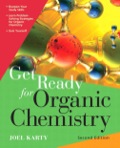
Concept explainers
Interpretation:
In the given graphic, the curved arrows that convert each resonance structure of
Concept introduction:
A resonance structure exists in species which have two or more valid Lewis structures. Resonance structures differ only in the placement of their valence electrons, not their atoms. Resonance structures are imaginary; the one, true species is represented by the resonance hybrid. A resonance hybrid is a weighted average of all resonance structures. The resonance hybrid looks most like the lowest energy (most stable) resonance structure. A resonance structure is lower in energy (i.e., more stable) with a greater number of atoms having an octet, with more covalent bonds, and with fewer atoms having a nonzero formal charge.
Want to see the full answer?
Check out a sample textbook solution
Chapter 6 Solutions
EBK GET READY FOR ORGANIC CHEMISTRY
- Hello I need some help with Smartwork. For drawing structure B, I know the correct answer is CH₃B₂, but when I try to type it in, it keeps giving me CH₄BH₃ instead. Do you know how I should write it properly? Should I use a bond or something else?arrow_forwardTrue or false, chemistryarrow_forwardanswer thse questions with mechanisms and steps. handwritten please!arrow_forward
- C app.aktiv.com Draw the product of the following reaction sequence. Ignore any inorganic byproducts formed. H O 1. (CH3CH2)2CuLi, THF 2. CH3Br Drawingarrow_forwardDraw the product of the following reaction sequence. Ignore any inorganic byproducts formed. H O 1. (CH3CH2)2CuLi, THF 2. CHзBr Drawingarrow_forwardSeee the attached imaarrow_forward
 Organic Chemistry: A Guided InquiryChemistryISBN:9780618974122Author:Andrei StraumanisPublisher:Cengage Learning
Organic Chemistry: A Guided InquiryChemistryISBN:9780618974122Author:Andrei StraumanisPublisher:Cengage Learning
